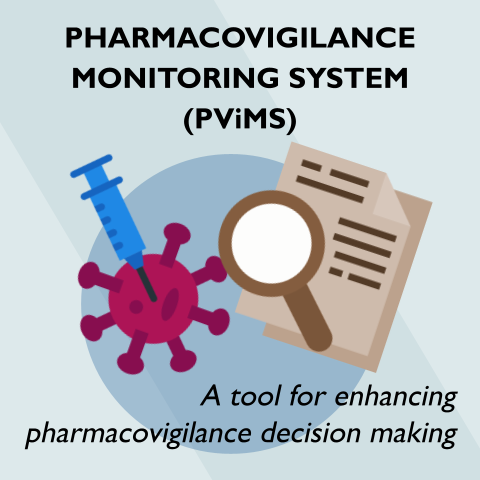Pharmacovigilance Monitoring System (PViMS) – A Tool to Enhance Decision-Making for Patient Safety
By Comfort Ogar, MTaPS
“Data really powers everything that we do.” – Jeff Weiner, LinkedIn Executive Chairman and ex-CEO
 As I walked into Dane’s* office that morning, I saw a pile of adverse drug reaction (ADR) reports that the pharmacovigilance (PV) center had received from health care providers and patients across the country. Dane looked at me with eyes tired from peering through her glasses at the ADR forms she had been reviewing. She welcomed me into her office for our scheduled meeting. When she saw my gaze fall on the pile of ADR reports on her table, she informed me that just that morning, they had received a report of a serious adverse reaction following the use of a new vaccine being administered through a vaccination campaign. Her boss had requested a summary report of all ADRs related to the vaccine that the center received. Looking at all the forms she had to review manually, I knew that this PV center was a prime candidate for PViMS.
As I walked into Dane’s* office that morning, I saw a pile of adverse drug reaction (ADR) reports that the pharmacovigilance (PV) center had received from health care providers and patients across the country. Dane looked at me with eyes tired from peering through her glasses at the ADR forms she had been reviewing. She welcomed me into her office for our scheduled meeting. When she saw my gaze fall on the pile of ADR reports on her table, she informed me that just that morning, they had received a report of a serious adverse reaction following the use of a new vaccine being administered through a vaccination campaign. Her boss had requested a summary report of all ADRs related to the vaccine that the center received. Looking at all the forms she had to review manually, I knew that this PV center was a prime candidate for PViMS.
This is a common scenario I encounter when I visit medicines regulatory agencies in countries supported through the US Agency for International Development (USAID) Medicines, Technologies, and Pharmaceutical Services (MTaPS) Program. Pharmacovigilance—the science and activities related to the detection, assessment, understanding, and prevention of adverse effects and other drug-related problems—depends on health care providers, patients, and caregivers documenting these effects. However, the efforts of those who report adverse effects and problems will not bring about any improvement if their reports are not analyzed and used to inform clinical and regulatory decisions that improve patient treatment outcomes.
In business, “the goal is to turn data into information, and information into insight” says Carly Fiorina, former executive, president, and chair of Hewlett-Packard Co. Like in business, the goal of PV should be to turn reports of adverse effects into information to improve patient outcomes. Therefore, a critical requirement for an effective PV system is to have the appropriate tools to promptly turn all adverse effect reports from passive and active surveillance systems into useful information.
In recognition of this need, the USAID-funded Systems for Improved Access to Pharmaceuticals and Services (SIAPS) program (2012–2017), which preceded MTaPS, developed PViMS—a web-based application used by clinicians, patients, regulatory bodies, and implementing partners to monitor the safety of medicines. PViMS makes it feasible to implement passive and active safety surveillance activities in low- and middle-income countries (LMICs). Unlike many other tools, it addresses the entire data collection and analysis process, from collecting patient-level information to conducting causality assessment and identifying signals of potential safety concerns. When used for spontaneous reporting, PViMS provides comprehensive PV solutions for LMICs given its versatile data collection abilities.
“Things get done only if the data we gather can inform and inspire those in a position to make [a] difference.” – Mike Schmoker, educator and author
Recognizing this fundamental fact, under SIAPS PViMS was deployed in the Philippines to support operational research for the introduction of the new, shorter treatment regimen and the bedaquiline-containing TB regimen between 2016 and 2017. About 12,000 adverse event reports were documented with the tool, providing data for analysis to inform clinical decisions. MTaPS currently supports several LMICs to use PViMS in their PV activities. In Mozambique, PViMS is being used to collect, manage, and analyze data obtained from the ongoing active safety surveillance of the HIV regimen tenofovir/lamivudine/dolutegravir in a cohort of 3,000 patients. Similarly, MTaPS supports the PV center of Rwanda and the pharmaceutical department in the Philippines to use PViMS to monitor the roll out of the Ebola vaccine and programmatic monitoring of TB medicines, respectively. MTaPS plans to deploy PViMS in Bangladesh, Jordan, Mozambique, and Rwanda for the roll out and monitoring of adverse events following immunization from the COVID-19 vaccines.
We call on health care providers, patients, and consumers to continue being vigilant and report the adverse effects of medicines and encourage PV centers to ensure timely analysis of the data to inform appropriate clinical and regulatory decisions.
To read about sex and gender in vaccine roll-out, read the Sex, Gender, and Vaccines: Considerations for COVID-19 Vaccine Immunity blog on the MTaPS website.
*not her real name